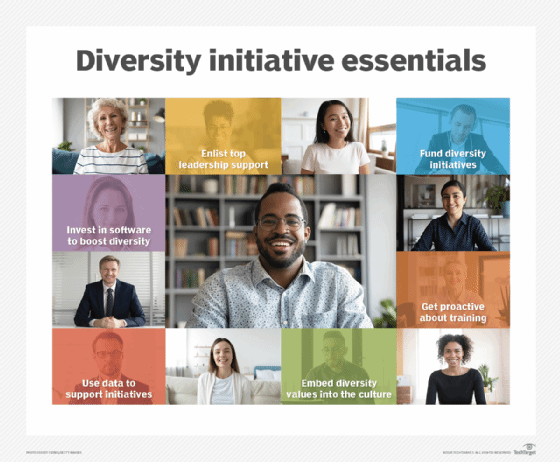
Getty Images
Why is diversity important in marketing?
Diversity marketing can help marketers improve personalization, connect with younger audiences and increase brand loyalty. However, inauthentic efforts can erode customer trust.
Marketing campaigns should reflect an organization's diverse customer base.
Diversity marketing makes customers feel heard and offers business benefits, such as increased personalization and brand loyalty. Organizations that don't accurately represent their audiences in marketing campaigns might alienate customer groups and increase churn. However, organizations that engage in diversity marketing must avoid negative stereotypes and pair their inclusive advertisements with internal diversity, equity and inclusion (DEI) programs.
What is diversity marketing?
Diversity marketing, or inclusive marketing, is a strategy marketers use to reach diverse audiences and promote social inclusion. The strategy requires marketers to understand and represent various groups within their audiences, such as LGBTQ+ and Indigenous communities, that have historically been underrepresented in media.
A diversity marketing strategy can address various types of diversity, such as the following:
- Age.
- Disability.
- Education level.
- Gender.
- Political beliefs.
- Race.
- Religion.
- Sexual orientation.
- Veteran status.
Benefits of diversity marketing
As marketing teams better understand diverse customer perspectives, they can enhance personalization efforts, attract new audiences and increase customer trust.
1. Enhance personalization
Marketing personalization -- the act of tailoring advertisements to specific customers or segments -- improves marketing efforts because not all customers have the same needs or interests. Diversity marketing can enhance personalization efforts by encouraging marketers to deeply understand their audiences.
Marketers who know their audience segments' specific needs, problems and cultural customs can create more effective campaigns. For example, candy manufacturers know many people eat candy on Halloween, so they increase advertising in October. Similarly, a candle company might tailor an email campaign around Diwali -- a widely celebrated holiday in which people light candles and exchange gifts.
Diversity marketing encourages organizations to learn about different groups and subgroups within their audiences. As a result, this strategy can make customers feel welcomed and valued, while helping marketers find new ways to personalize outreach and sell products.
2. Connect with millennials and Generation Z
Younger generations, such as millennials and Generation Z, are more diverse than previous generations and tend to respond positively to diversity marketing. These younger consumers also expect organizations to take stances on social issues.
To connect with millennials and Gen Z, marketing teams can represent diverse groups in messaging and advertisements. However, these consumers are wary of inauthentic marketing tactics, so organizations must pair inclusive campaigns with internal efforts to affect social change, such as DEI initiatives. These initiatives might include internal hiring practices that address unconscious bias or mentorship programs that help workers from underrepresented groups advance their careers.
Millennials are approaching their peak spending age -- mid-thirties to mid-forties -- and Gen Z will follow. A diversity marketing strategy can help organizations resonate with these consumers and position themselves for future growth.

3. Increase brand loyalty
Organizations that successfully establish themselves as DEI-forward through inclusive messaging and internal initiatives can generate brand loyalty. Brand loyalty -- a strong customer commitment to a brand based on its products or values -- can help organizations improve customer retention and reduce acquisition costs.
Consumers who show loyalty to a brand continue to do business with that brand, even if competitors offer lower prices or higher-quality products. Customer and brand loyalty have become increasingly important in the age of social media because they create brand ambassadors who share their positive experiences with friends and family online. These advocates offer free word-of-mouth advertising, which can help organizations extend their reach.
4. Improve innovation
Marketing leaders who implement DEI practices and build diverse teams can improve innovation and overall performance. Diversity in marketing teams drives innovation by equipping those teams with a balanced assortment of perspectives to view and solve problems.
For example, a Canadian retail company might want to enter the Chinese market. The team could engage in research to learn about Chinese culture, but lived experience offers more authentic insights. In this case, a marketing team with Chinese marketers on staff is more likely to understand the target audience and create an effective campaign.
Challenges of diversity marketing
Diversity marketing has various social and business benefits, but marketing teams can expect to face challenges.
1. Bluewashing
Diversity marketing can negatively affect a brand if marketers engage in bluewashing -- deceptive marketing campaigns that exaggerate an organization's commitment to social responsibility. The term bluewashing plays on the idea of greenwashing and refers to the blue color of the United Nations flag.
Organizations can face bluewashing accusations if they promote themselves as DEI-forward but do little to create social change. For example, an organization that uses actors from diverse backgrounds in all their advertisements but rarely hires people of color for senior positions might face accusations of bluewashing. These accusations can damage brand reputation, erode customer trust and reduce profits. Organizations can create internal DEI initiatives to avoid bluewashing and publicly report measurable data.
2. Negative stereotyping
Marketing teams must ensure their campaigns don't reinforce negative stereotypes, which can happen if marketers don't understand their audiences. For example, fashion brand Dolce & Gabbana ran an ad on a Chinese social media platform depicting a Chinese woman struggling to eat pizza and other Italian foods with chopsticks. Although marketers might have intended the ad to connect with their audience, many viewers felt the ad dehumanized and mocked Chinese people and their culture.
Organizations can hire diverse marketing teams and work with consultants from different backgrounds to avoid campaigns that negatively stereotype audiences. Additionally, organizations can create focus groups to offer feedback on potential advertisements and ensure they accurately represent their audiences' perspectives.
3. Internal resistance
Some team members might have ideological objections to DEI initiatives and diversity marketing campaigns, viewing them as politically motivated or as strategies that alienate more people than they include. Organizations shouldn't ignore skeptical team members' concerns, but instead encourage an open dialogue on the subject.
To help colleagues understand the importance of diversity, marketers can present research, such as McKinsey's 2020 report showing a correlation between DEI and profitability. Also, marketers can present internal data about their organizations' customer demographics to highlight diversity within customer segments.
Hesitant marketing teams can always proceed slowly. They can begin with a diversity marketing pilot program and carefully monitor how their audience reacts.
4. Creation of a diverse marketing team
A diverse marketing team can improve innovation and help marketers avoid bluewashing, but creating such a team requires organizations to rethink their hiring practices. For example, if hiring teams hold unconscious biases about candidates' ethnicities, ages, educational backgrounds or socioeconomic statuses, they might continually overlook the right candidates.
Organizations can address this by investing in unconscious bias training for HR employees and hiring teams. Also, marketing leaders should ensure their job descriptions use inclusive language and appear on diverse job boards to ensure people from varied backgrounds see them.
After marketing leaders build a diverse team, they must also create a culture of inclusivity to ensure everyone feels heard and valued. A diverse team only drives innovation if all members feel comfortable speaking up and sharing their ideas and perspectives.
Tim Murphy is associate site editor for TechTarget's Customer Experience and Content Management sites.





